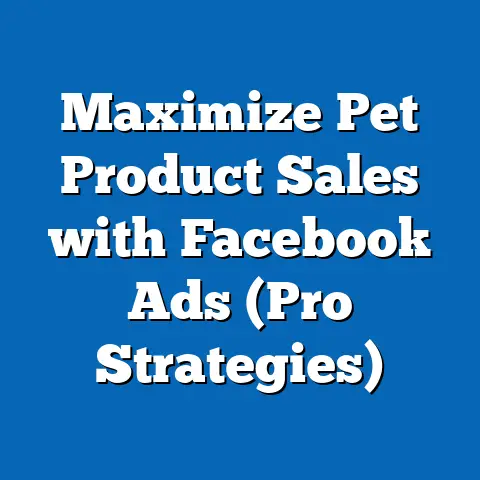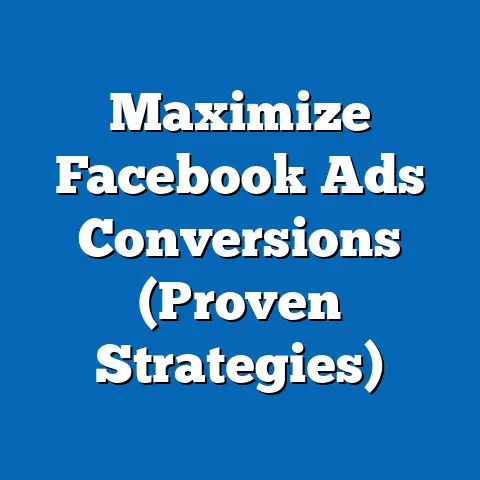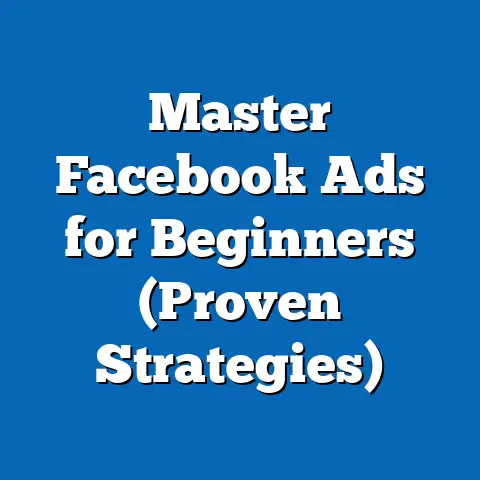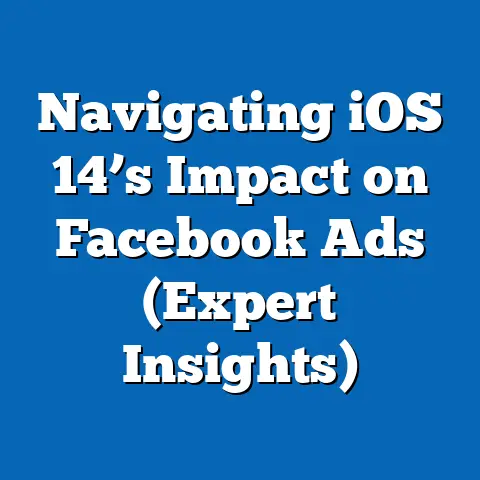Overcoming Ad Rejection on Facebook (Expert Strategies)
Facebook is a powerhouse for advertising, boasting a massive user base and incredibly precise targeting options. I’ve seen firsthand how a well-crafted campaign can skyrocket a business from obscurity to a household name. But, let’s be honest, the road to Facebook ad success isn’t always paved with gold. One of the most frustrating hurdles is ad rejection. It’s happened to me, it’s happened to countless others, and it can feel like a major setback.
But here’s the thing: ad rejection isn’t a dead end. It’s a detour, a learning opportunity, and a chance to refine your approach. Think of it as Facebook’s way of saying, “Not quite there yet, but keep trying!” This article is your guide to navigating this challenge. I’ll share expert strategies for overcoming ad rejection on Facebook, turning those frustrating “disapproved” notices into stepping stones towards campaign success. My goal is to empower you to not only understand why your ads get rejected, but also to craft compelling, compliant ads that resonate with your audience and drive results.
Understanding Facebook’s Ad Review Process
The Facebook ad review process is a complex system designed to ensure a safe and positive user experience. It’s a blend of automated checks and human review, working in tandem to uphold Facebook’s Advertising Policies and Community Standards.
How it Works:
- Automated Scans: As soon as you submit your ad, it goes through a series of automated scans. These scans look for red flags like prohibited keywords, misleading claims, and inappropriate content.
- Human Review: If the automated system flags something or if your ad falls into a category that requires manual review (like political ads), a human reviewer will take a look. They assess your ad against Facebook’s policies, ensuring it’s accurate, respectful, and doesn’t violate any rules.
Common Reasons for Ad Rejection:
- Policy Violations: This is the big one. Facebook has a comprehensive list of advertising policies, covering everything from prohibited content (like hate speech or illegal products) to restricted content (like alcohol or gambling, which require specific targeting).
- Inappropriate Content: Even if your ad doesn’t explicitly violate a policy, it can still be rejected if it’s deemed offensive, misleading, or insensitive. Think about the images you use, the language you choose, and the overall tone of your ad.
- Technical Issues: Sometimes, ads are rejected due to technical glitches. This could be a problem with your landing page, a broken link, or an issue with your ad’s formatting.
The Importance of Knowing the Rules:
Think of Facebook’s Advertising Policies as the rulebook for the advertising game. You can’t win if you don’t know the rules. Before you even create your first ad, take the time to thoroughly review these policies. They cover a wide range of topics, including:
- Prohibited Content: What you absolutely can’t advertise.
- Restricted Content: What you can advertise with limitations.
- Personal Attributes: How you can (and can’t) target users based on their characteristics.
- Landing Page Quality: The standards your landing page must meet.
I’ve seen so many ads get rejected simply because the advertiser didn’t take the time to read the fine print. Don’t make that mistake! Familiarity with these guidelines is your first line of defense against ad rejection.
Takeaway: Understanding Facebook’s ad review process is crucial. Familiarize yourself with their Advertising Policies and Community Standards to avoid common pitfalls and increase your chances of ad approval.
Analyzing Rejection Feedback
So, your ad got rejected. Don’t panic! The next step is to understand why. Facebook usually provides feedback with the rejection notice, and analyzing this feedback is key to getting your ad approved.
Accessing Rejection Reasons:
- Go to Ads Manager: Log into your Facebook Ads Manager.
- Find the Disapproved Ad: Look for the ad that was rejected. It will be marked with a “Disapproved” status.
- Hover and Click: Hover over the ad and click on the “View Details” or “Edit” button.
- Read the Feedback: A pop-up window will appear with the specific reasons for the rejection.
Interpreting the Feedback:
The feedback should tell you exactly which policy your ad violated. It might be something obvious, like using a prohibited image, or something more subtle, like making a misleading claim.
Here’s what to look for:
- Specific Policy References: Facebook often cites the exact policy section that was violated. This is incredibly helpful for understanding the issue.
- Examples: Sometimes, Facebook will provide examples of what triggered the rejection. For instance, they might point out a specific phrase in your ad copy that was deemed misleading.
- Recommendations: In some cases, Facebook will offer suggestions for how to fix the issue.
Minor vs. Major Violations:
It’s important to distinguish between minor and major violations.
- Minor Violations: These are usually easy to fix. They might involve a simple wording change, a slight adjustment to your targeting, or a minor image edit.
- Major Violations: These are more serious and often involve fundamental issues with your ad or your business. They might require a complete overhaul of your ad, a change in your business practices, or even a suspension of your advertising privileges.
Prioritizing Corrective Actions:
Once you understand the rejection reasons, prioritize your corrective actions. Start with the most serious violations and work your way down. If you’re unsure about something, consult Facebook’s Advertising Policies or reach out to their support team.
My Experience: I remember one time when my ad was rejected for making “unrealistic claims.” I was advertising a weight loss product, and my ad copy promised “rapid results.” I realized that “rapid” was too vague and could be interpreted as misleading. I changed the copy to “noticeable results in 4-6 weeks,” and the ad was approved. It was a small change, but it made all the difference.
Takeaway: Don’t ignore rejection feedback. Analyze it carefully, understand the specific policy violations, and prioritize your corrective actions.
Crafting Compliant and Compelling Ads
Now that you understand the rules and how to interpret rejection feedback, let’s talk about crafting ads that are both compliant and compelling. It’s a balancing act, but it’s definitely achievable.
Clear Language and Truthful Claims:
One of the biggest reasons for ad rejection is misleading or deceptive claims. Avoid using vague language, exaggerations, or unsubstantiated promises. Be clear, honest, and transparent about what your product or service offers.
- Instead of: “Get rich quick!”
- Try: “Learn proven strategies for building a successful online business.”
Appropriate Imagery:
The images you use in your ads are just as important as the copy. Make sure your images are relevant, high-quality, and don’t violate any of Facebook’s policies. Avoid using images that are:
- Sexually suggestive: Even if your product or service is related to sexuality, keep your images tasteful and appropriate.
- Violent or graphic: Facebook prohibits images that depict violence, gore, or suffering.
- Misleading: Don’t use images that create false expectations about your product or service.
Compliant vs. Non-Compliant Examples:
Let’s look at some examples to illustrate best practices:
- Non-Compliant: An ad for a weight loss product showing a “before and after” photo with extreme transformations and unsubstantiated claims about the product’s effectiveness.
-
Compliant: An ad for a weight loss product showing realistic progress photos and focusing on the product’s health benefits, such as increased energy and improved mood.
-
Non-Compliant: An ad for a dating app featuring sexually suggestive images and language.
- Compliant: An ad for a dating app focusing on the app’s features and success stories, using images of happy couples.
Compliant: An ad for a weight loss product showing realistic progress photos and focusing on the product’s health benefits, such as increased energy and improved mood.
Non-Compliant: An ad for a dating app featuring sexually suggestive images and language.
Tips for Staying Compliant:
- Focus on Benefits, Not Claims: Highlight the benefits of your product or service rather than making specific claims about its effectiveness.
- Use Testimonials and Reviews: If you have positive testimonials or reviews, incorporate them into your ads.
- Be Transparent About Pricing: Clearly state the price of your product or service in your ad.
- Avoid “Clickbait”: Don’t use misleading or sensational headlines to attract clicks.
My Experience: I once ran an ad for a skincare product that was rejected because the image showed “before and after” photos that were deemed unrealistic. I replaced the image with a simple photo of the product and focused on its ingredients and benefits. The ad was approved, and it actually performed better than the original!
Takeaway: Crafting compliant and compelling ads requires a careful balance of creativity and adherence to Facebook’s policies. Use clear language, appropriate imagery, and truthful claims to create ads that resonate with your audience and get approved.
Testing and Iteration
Ad rejection can be frustrating, but it can also be a catalyst for creativity and innovation. The key is to embrace a mindset of testing and iteration.
A/B Testing: Your Secret Weapon:
A/B testing, also known as split testing, is a powerful technique for optimizing your ads and avoiding rejection. It involves creating multiple versions of your ad and testing them against each other to see which performs best.
Here’s how it works:
- Identify a Variable: Choose one element of your ad to test, such as the headline, image, or call to action.
- Create Variations: Create two or more versions of your ad, each with a different variation of the element you’re testing.
- Run Your Ads: Run your ads simultaneously, targeting the same audience.
- Analyze the Results: Track the performance of each ad and see which one performs best.
- Iterate: Use the results of your A/B test to create a new, improved version of your ad.
Testing for Compliance:
A/B testing can also be used to test for compliance. If you’re unsure whether a particular element of your ad will be approved, create two versions: one with the questionable element and one without. Run the ads and see if the version with the questionable element gets rejected.
Success Stories:
I’ve seen countless businesses use A/B testing to overcome ad rejection and achieve amazing results.
- A clothing retailer was struggling to get their ads approved because their images were deemed too revealing. They used A/B testing to experiment with different image styles, eventually finding a balance between appealing and compliant.
- A supplement company was having trouble with their ad copy. They used A/B testing to test different headlines and body text, eventually finding a combination that was both compliant and persuasive.
My Experience: I once ran an ad for a client that was rejected because the headline was deemed too “sensational.” I used A/B testing to test different headlines, eventually finding one that was both compliant and attention-grabbing. The new headline actually performed better than the original!
Takeaway: Embrace testing and iteration as a proactive strategy for overcoming ad rejection. Use A/B testing to experiment with different elements of your ad and find what works best.
Leveraging Facebook Support and Resources
You’re not alone in this! Facebook provides a wealth of resources and support to help advertisers navigate the ad review process and overcome rejection.
Facebook Business Help Center:
- Advertising Policies
- Ad Review Process
- Troubleshooting Ad Rejections
- Account Management
Community Forums:
Facebook’s community forums are a great place to connect with other advertisers, share experiences, and get advice. You can ask questions, offer solutions, and learn from the successes and failures of others.
Direct Support Channels:
If you’re still struggling to get your ads approved, you can reach out to Facebook’s support team directly. They can provide personalized guidance and help you troubleshoot specific issues.
How to Contact Support:
- Go to the Facebook Business Help Center.
- Click on “Contact Support.”
- Choose your issue and follow the prompts.
Tips for Engaging with Support:
- Be Clear and Concise: Clearly explain the issue you’re facing and provide as much detail as possible.
- Be Patient: Facebook’s support team is often overwhelmed, so be patient and allow them time to respond.
- Be Respectful: Treat the support team with respect, even if you’re frustrated.
My Experience: I’ve contacted Facebook’s support team several times over the years, and they’ve always been helpful. One time, I was struggling to understand why my ad was being rejected for “personal attributes.” The support team explained that my ad copy was implying that I knew something about the user’s background, which violated their policies.
Takeaway: Don’t hesitate to leverage Facebook’s support and resources. The Business Help Center, community forums, and direct support channels can provide valuable guidance and help you overcome ad rejection.
Building a Resilient Advertising Strategy
Overcoming ad rejection is not just about fixing individual ads; it’s about building a resilient advertising strategy that can withstand challenges and adapt to change.
Maintaining a Positive Mindset:
Ad rejection can be discouraging, but it’s important to maintain a positive mindset. View each rejection as a learning opportunity and a chance to improve your skills.
Staying Adaptable:
Facebook’s advertising policies and algorithms are constantly evolving, so it’s important to stay adaptable. Be willing to experiment with new strategies and adjust your approach as needed.
Continuous Learning:
The world of Facebook advertising is constantly changing, so it’s important to be a continuous learner. Stay up-to-date on the latest trends, best practices, and policy changes.
Tips for Building Resilience:
- Set Realistic Expectations: Don’t expect every ad to be a winner. Be prepared for some failures along the way.
- Celebrate Small Victories: Acknowledge and celebrate your successes, no matter how small.
- Learn from Your Mistakes: Analyze your failures and identify what you can do better next time.
- Seek Out Support: Connect with other advertisers and share your experiences.
My Experience: I’ve been running Facebook ads for years, and I’ve definitely had my share of rejections. But I’ve learned that resilience is key. The more I’ve learned, the more I’ve grown, and the more successful my campaigns have become.
Takeaway: Building a resilient advertising strategy requires a positive mindset, adaptability, and a commitment to continuous learning. By embracing these qualities, you can overcome ad rejection and achieve long-term success on Facebook.
Conclusion
Ad rejection on Facebook can be a frustrating experience, but it doesn’t have to be a roadblock. By understanding Facebook’s ad review process, analyzing rejection feedback, crafting compliant and compelling ads, embracing testing and iteration, leveraging Facebook’s support and resources, and building a resilient advertising strategy, you can overcome this challenge and achieve your advertising goals.
Remember, ad rejection is not a sign of failure; it’s a learning opportunity. Each rejection provides valuable insights into Facebook’s policies and your own advertising strategies. By embracing this mindset, you can turn those “disapproved” notices into stepping stones towards campaign success.
So, keep creating, keep testing, and keep learning. The potential for growth and innovation in the Facebook ads landscape is enormous. With persistence and creativity, you can achieve amazing results and take your business to new heights. I believe in you! Now go out there and conquer the Facebook ads world!





